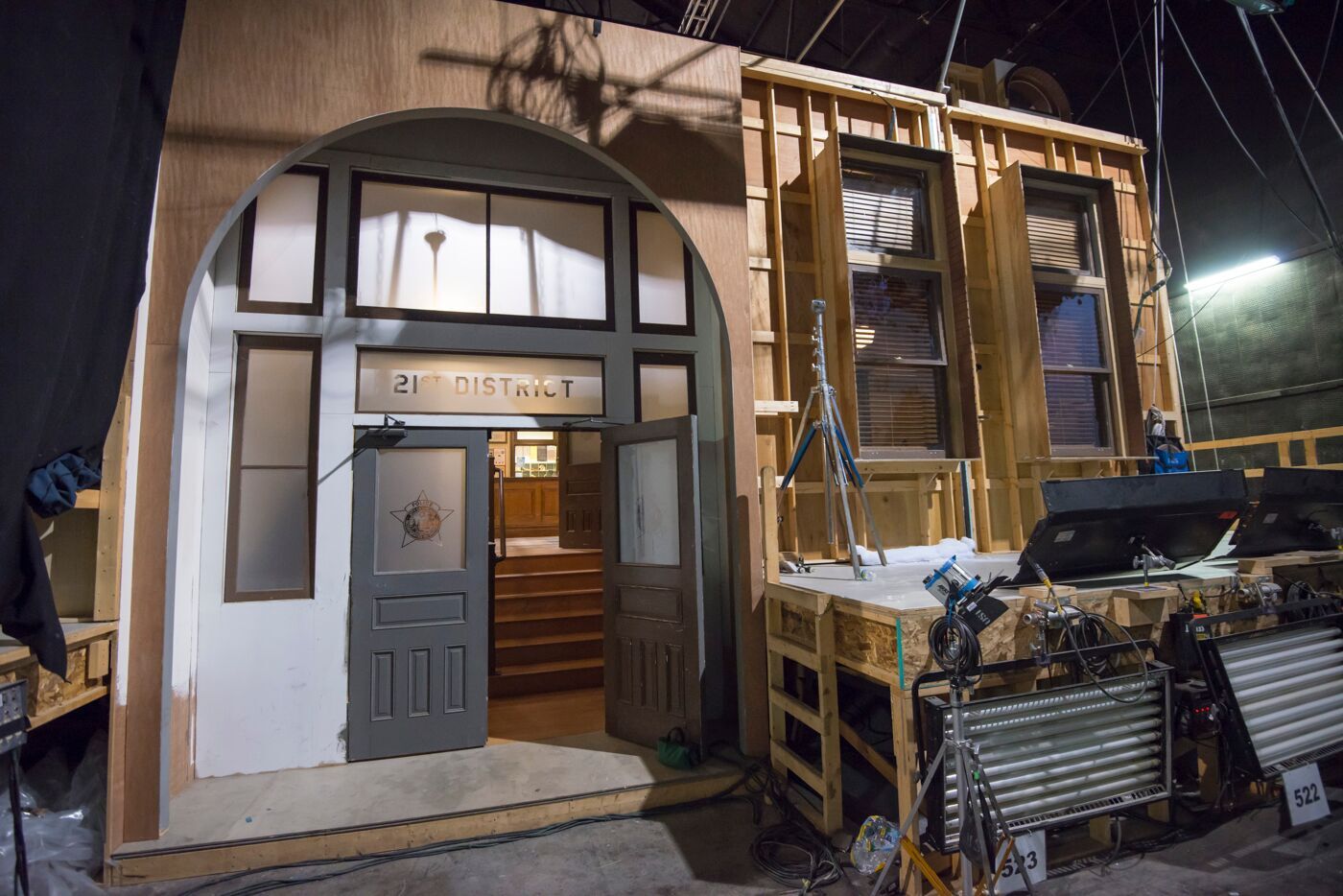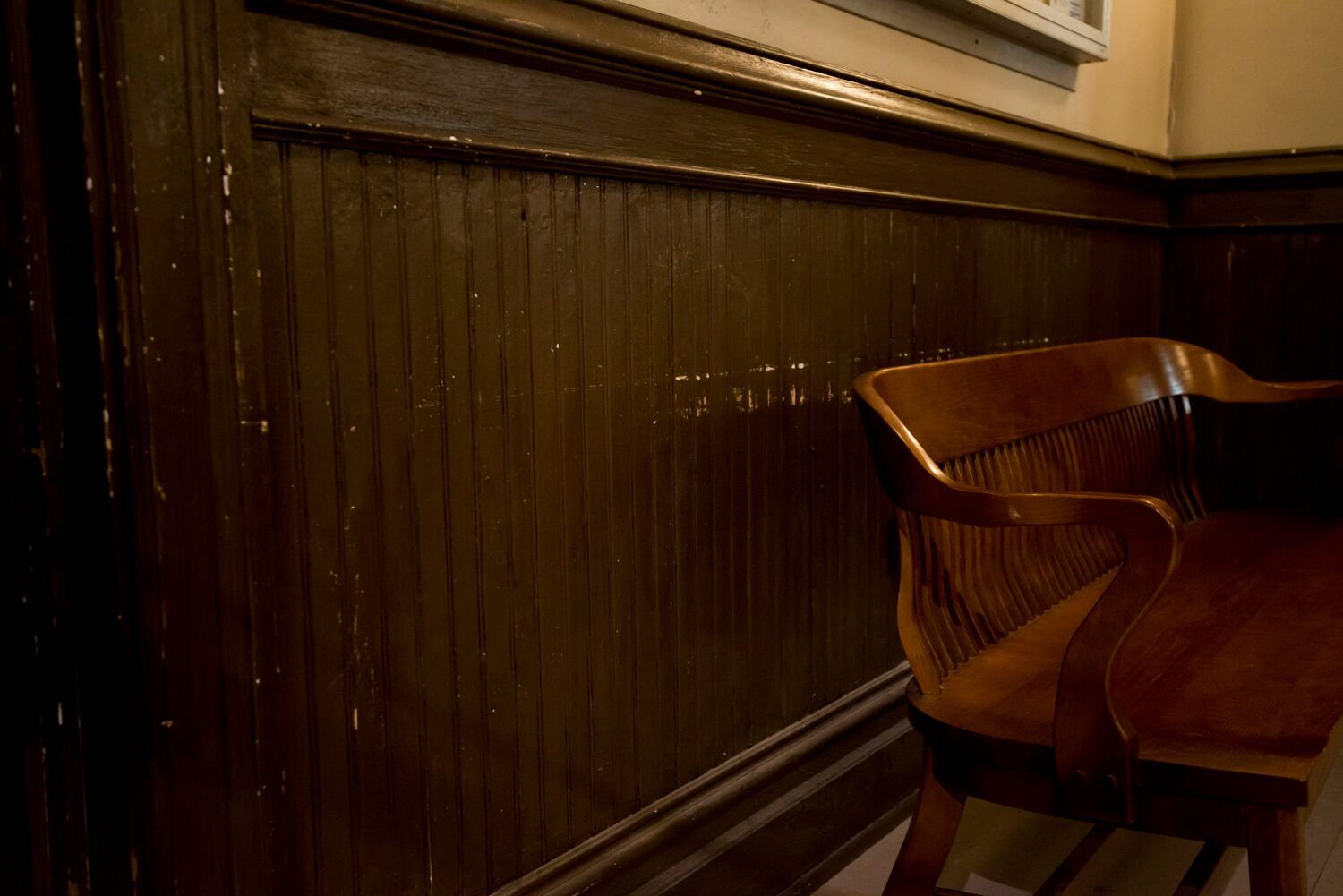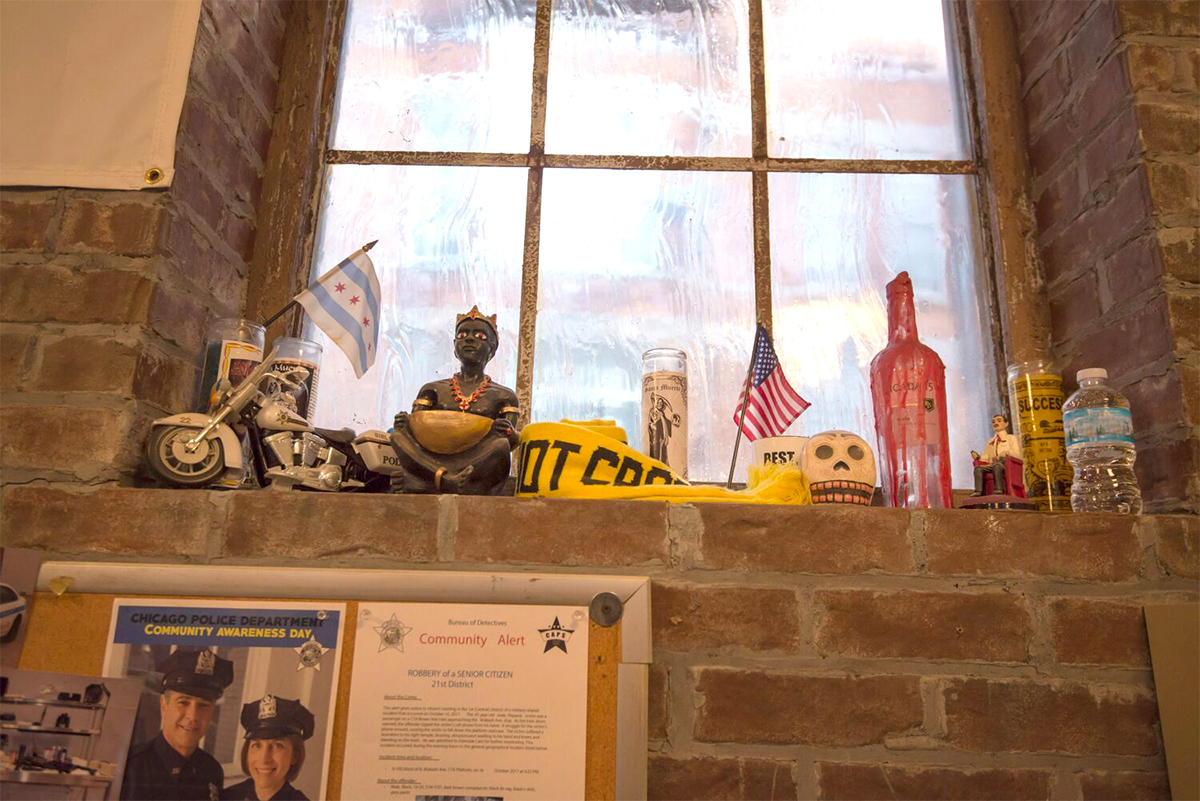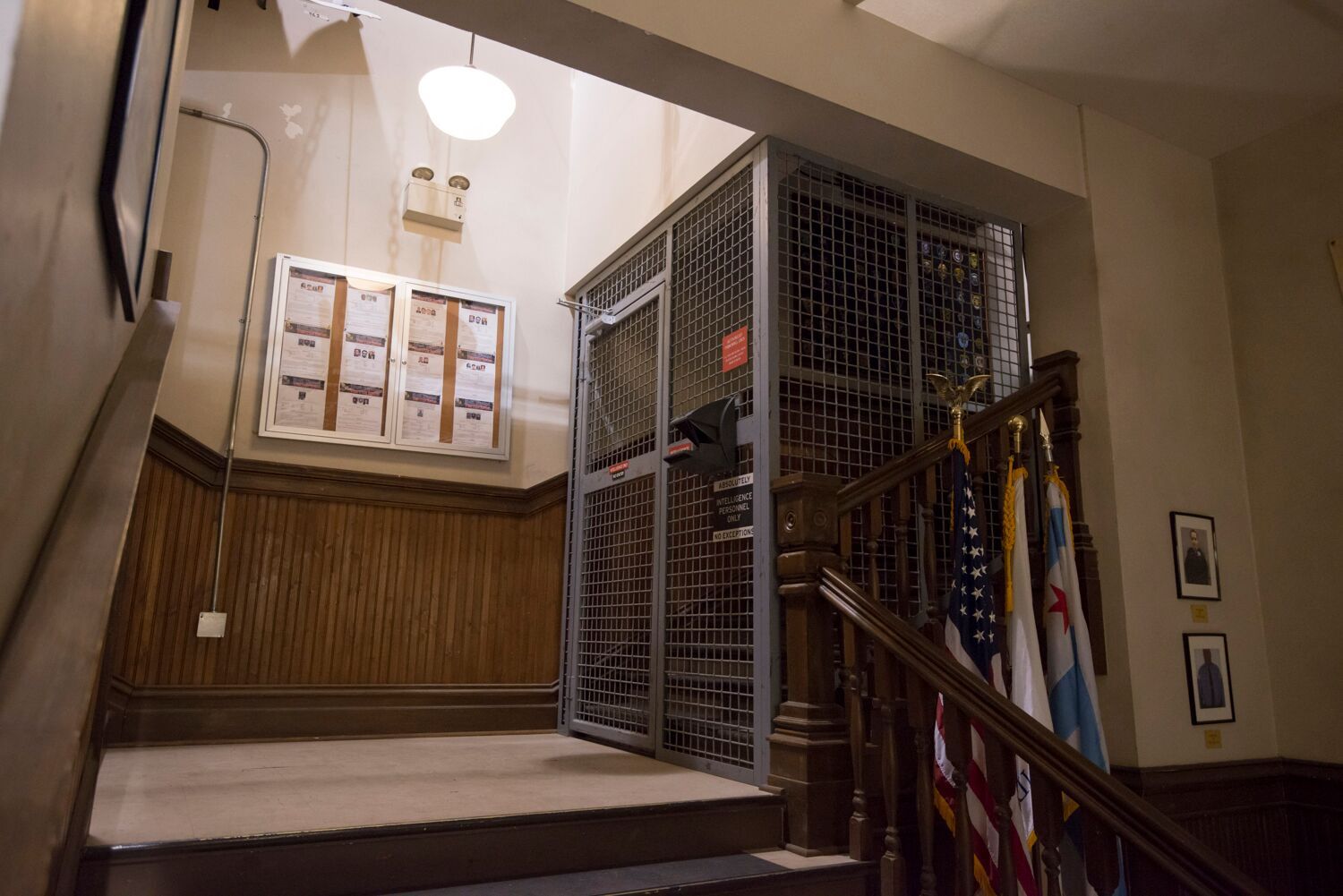Subscribe to NCS for the latest news, project case studies and product announcements in broadcast technology, creative design and engineering delivered to your inbox.
A hallmark of the production design for “Chicago PD” — part of a trio of three shows that take place inside the same fictional universe of a major metropolitan hospital, fire station and police department — is the art of making newly constructed sets look worn and aged.
While it might seem easy enough to make surfaces look old, it actually takes incredible attention to detail, strategic planning and the talent of a wide range of craftspeople, according to the show’s production designer, Gregory Van Horn.
“PD” was the second in NBC’s series of shows surrounding law enforcement and first responders in a fictional version of Chicago — starting production in 2013, a year after “Chicago Fire.” “Chicago Med” would eventually join the lineup and is filmed in the same complex of studios.
Real meets fictional
Its primary standing set is a precinct building that serves as the home of the Intelligence Unit within the 21st District of the Chicago Police Department, which is based on the real 7th District Police Station at 949 West Maxwell Street — just like the “Chicago Fire” Station 51 is based on one of the city’s real firehouses.

The faux entrance to the ‘Chicago PD’ precinct set is based on a real Chicago police building.
The real life building was built in 1888, so the directive for the permanent sets was to make them feel as worn as possible for the bullpen and desk areas, as if the station had been in use for decades, explained Van Horn.
Stage 10 in Cinespace Chicago is home to the police station sets — which center mainly around an upstairs bullpen and the main lobby connected by a series of hallways that lead to holding cells, interrogation rooms and other areas.

Architectural elements from the real building, which is still used for some on location shooting, is mirrored in Van Horn’s designs — notably the arched windows, brickwork and the impressive stone arch around the main entrance to the building, which actually has a full replica built on the show’s soundstage.
A design investigation
When creating the 21st District’s offices, Van Horn and his team of course had the real life building as a reference point.
He and set decorator Tricia Schneider performed exhaustive research of how real police stations, in particular investigate units, are laid out and function to serve the unique needs.
In addition, they rely heavily on information and photos provided by police technical advisers Brian Luce and Walt Smith for advice on how to create realistic designs that also allow functional storytelling areas for writers, directors and directors of photography to work in.
“The bullpen remains my favorite set, still to this day. We continuously tweak it, especially the set dressing, either for a specific episode, or to update it over the past five seasons.”
One of the central locations for the show, the “bullpen,” was carefully predicated on a variety of factors, but mainly the interaction between one the show’s principal characters and the division leader, Sergeant Hank Voight, explained Van Horn.
“A lot of thought went what kind of action takes place in the bullpen, specifically laying out the case on the whiteboard, analysis of evidence and data gleaned from various police computer applications,” he said.
Having some work done
Given the age of the building the show’s station is based on, quite a lot of effort went into adding cracks, chips and wear and tear throughout the spaces.

The level of detail in aging the ‘Chicago PD’ sets is so specific that even the spot where the back of this bench hits the wainscoting has been given some ‘extra attention.’
“I personally took a hammer to the set to dent areas, which were then re-aged with paint as necessary,” he said.
But the aging process goes beyond just swinging hammers into walls — the production design team put an incredible amount of thought into has specific surfaces would age over the years.

“Wherever we felt that there was lots of foot traffic, we distressed the floor, walls, doors and jambs to enhance that look” — where other areas that might not get as much get more subtle aging treatments.
The attention to detail even goes down to what looks like years of smudge marks around light switches and door handles down to tiny scratches and dents in the woodwork.
The evolving nature of how police work in general has changed over the years is also evident, with details such as exposed wiring runs for data lines running down hallways — perhaps the result of a bureaucrat’s efforts to save money or the challenges of adding new infrastructure to an aging building — or a mix of both.
“A lot of thought went what kind of action takes place in the bullpen, specifically laying out the case on the whiteboard, analysis of evidence and data gleaned from various police computer applications”
In that same hallway, meanwhile, a beaten up photocopier of questionable functionality sits — seemingly parked, perhaps temporarily, in an open free spot that eventually morphed into its permanent home.
This level of detail gives the show a distinct tone and look that not only speaks to the gritty work of criminal investigation but also the very real challenges of police having to do more with less, including out of decades-old buildings that aren’t necessarily ideal for their work.
Adding life, personality
The show’s characters however, haven’t let the age or condition of their fictional station stand in the way of trying to liven things up with both bits of personality and mementos from their biggest capers.

The squad room’s tribute to Malverde, a Mexican ‘bandit for the poor’ is one of the many details that appear on set.
For example, scattered around the bullpen set is a wide array of peculiar objects that at first glance seem a bit out of place: A boar’s head, a display of shivs and knives, a shrine to Malverde, a Mexican folklore hero known as the “bandit for the poor.”

“These are all trophies, taken from gang lair or drug stash house, or other bust. They lend a very authentic touch to the police environment,” explained Van Horn.
The bullpen also has plenty of Chicago references and personal items scattered around — including momentos representing many of the characters’ back stories.
“Our biggest challenge on an episode to episode basis is the shear number of locations. These locations are intrinsic to the show, but we strive hard to make the unique and interesting in their own right…”
An exposed brick wall with high window ledges plays home to much of these carefully curated items as well as the famous Chicago Cubs “W” flag that is traditionally flown after home Cubs wins. If you look carefully, however you’ll notice the letter “W” has gained a thin outline and uses a slightly different font — a clever workaround to the often complex world of sports licensing issues.
“The bullpen remains my favorite set, still to this day. We continuously tweak it, especially the set dressing, either for a specific episode, or to update it over the past five seasons. The deliberate aging has also been enhanced by aging over time both by actors and crew” said Van Horn.
Two floors — on one floor
The bullpen set is notably built on a raised platform in the middle of the soundstage — a move that Van Horn used in order to create what is affectionately known as the “stairway to nowhere.”

One half of the ‘stairway to nowhere’ that simulates the connection between the first and upper floors of the police precinct set.
This is a reference to the wide, wooden stairs that lead into the bullpen that go down about half a floor before jutting left — and leading off camera to outside of the set.
Adjacent to the bullpen set a smaller front desk and lobby set that include an additional short flight of stairs leading down to the faux exterior doors.
Upon entering the lobby set, two staircases branch up to the right — with the one surrounded with a formidable security cage supposedly leading to the bullpen area.
In reality, scenes that require moving from one floor require actors to climb the stairs in the lobby set, come back down and then move to the bullpen set, walk down those stairs and and pretend to continue their walk back up from the ground floor — a sort of low tech wormhole that ends up looking seamless thanks to the show’s film editors.
Another bit of creative license was taken for the show’s lobby entrance set.
During their research, Van Horn and his team observed that most police stations have a cavernous lobby that is bisected by plexiglass enclosed desk area that’s designed to keep the desk workers safe.
“We eliminated the plexiglass to create a much more interactive set,” explained Van Horn.

Indeed, the space’s warm woods, high ceilings and hotel lobby-style “check in desk” not only give the space a more inviting look, but also helps enhance dialogue and interaction between actors on both sides of the set.
“The front desk area, a more public space, was designed as a stage on which to choreograph the ‘ballet’ of everyday coming and goings of our characters, uniform police and other principal characters,” explained Van Horn.
Big challenges come in small packages
Ironically, one of the most challenging sets to build and manage, according to Van Horn, are the show’s multiple small interrogation rooms.
While one might think these are simple rooms on the surface, they actually provided Van Horn and his team with some of their biggest challenges.

“Because of their simplicity — they are basically boxes — we went through several iterations of texture, such as brick, acoustical tiling, layers of paint and age, until we got them right,” he explained.
The interrogation rooms also feature the obligatory observation windows that detectives, officers and lawyers can observe interviews through — but even these aren’t a straightforward as they look.
“The size of the sets is very important to Dick Wolf. The smaller the better, while still shootable, is the standard template.”
In fact, these windows have multiple versions — some that serve as more of an actual mirror on one side while being complete opaque on the other with others that are translucent on both sides. These panels are are removable and reversible and can also be angled to avoid reflecting light or crew.
The ever changing nature of television dramas means that the precinct can change and evolve over time.
Van Horn and his team are planning to flesh out the show’s district station set with departments such as the roll-call room, fitness room and hallways — just like you’d find in a real police station.
“Adding new areas to the set also gives the writing team the chance for characters to meet up, either clandestinely or publicly, in a setting other than the bullpen or front desk,” explained Van Horn.
Outside the precinct
Beyond the station, there is, of course, a myriad of additional sets that set the scene for any number of settings that scripts might call for.
The show’s police technical advisers play a key role as well as phone interviews with other police departments often play a key role in the development and design of these steps, which can include everything from safe houses, stash houses or other police facilities.
As storylines demand, temporary swing sets that are generally only used once or twice can be built on demand — or locations throughout the Chicagoland area may be scouted and used if recreating a particular space would be impractical.
 Photo courtesy Gregory Van Horn
Photo courtesy Gregory Van Horn
A more recent addition to the “Chicago PD” arsenal of sets is a polygonal, two tiered crime lab set for the hard working lab techs who, either through real or “TV magic” science help solve cases.
Schneider and Van Horn also work work to extensively research various swing and location sets, including crime scene and everyday locales, as the scripts call for them.
Architectural elements from the real building, which is still used for some on location shooting, is mirrored in Van Horn’s designs
When designing all of these, special attention is paid from both the production design and set decorator teams to create environments that are both visually interesting and give off a decidedly Chicago look and feel while still remaining true to script requirements and giving each location a unique look and feel.
“Our biggest challenge on an episode to episode basis is the shear number of locations. These locations are intrinsic to the show, but we strive hard to make the unique and interesting in their own right, rather just another drug den, or bar, or what have you,” said Van Horn.
Thankfully, Chicago’s architecture is packed with a plethora of unique textures, materials and techniques that give designers plenty to draw from.
In may cases, like on many TV shows, some liberties are taken with the scale and scope of sets — such as widening sets meant to be inside the city’s familiar but narrow row houses to be a bit wider and feature a bit more than might be found in a typical Chicago apartment — or affordable given the character’s budget.
Inside the Wolf universe
“Chicago PD,” like its other Chicago-based counterparts “Chicago Med” and “Chicago Fire,” all take inside a fictional version of Chicago as well as New York City, as the series have crossed over to both the “Law & Order” and “Law & Order: SVU” series as well.
All of these shows are executive produced by Dick Wolf — who makes it a point to work closely with his production design team.
The ever changing nature of television dramas means that the precinct can change and evolve over time.
“The size of the sets is very important to Dick Wolf. The smaller the better, while still shootable, is the standard template. We downsized the bullpen several times until we got it right,” said Van Horn.
One of the show’s courtroom scenes, for example, was originally set to be shot on location, but it’s surprisingly challenging to find courtroom sets that meet the production’s needs — so Van Horn’s team was tasked with creating their own version.
Paying homage to Wolf’s vision for production design, the courtroom set the “Chicago” team built was exactly the same size as one of the ones built in New York for “Law & Order.”
Photos by Dak Dillon and Gregory Van Horn
Subscribe to NCS for the latest news, project case studies and product announcements in broadcast technology, creative design and engineering delivered to your inbox.






